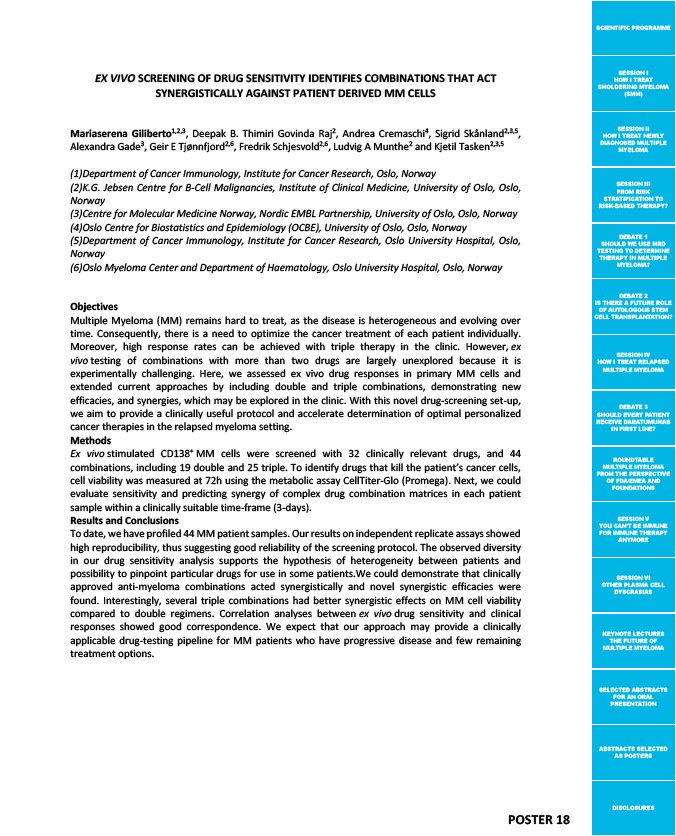
SCIENTIFIC PROGRAMME
SESSION I
HOW I TREAT
SMOLDERING MYELOMA
(SMM)
SESSION II
HOW I TREAT NEWLY
DIAGNOSED MULTIPLE
MYELOMA
SESSION III
FROM RISK
STRATIFICATION TO
RISK-BASED THERAPY?
DEBATE 1
SHOULD WE USE MRD
TESTING TO DETERMINE
THERAPY IN MULTIPLE
MYELOMA?
DEBATE 2
IS THERE A FUTURE ROLE
OF AUTOLOGOUS STEM
CELL TRANSPLANTATION?
SESSION IV
HOW I TREAT RELAPSED
MULTIPLE MYELOMA
DEBATE 3
SHOULD EVERY PATIENT
RECEIVE DARATUMUMAB
IN FIRST LINE?
ROUNDTABLE
MULTIPLE MYELOMA
FROM THE PERSPECTIVE
OF FDA/EMEA AND
FOUNDATIONS
SESSION V
YOU CAN’T BE IMMUNE
FOR IMMUNE THERAPY
ANYMORE
SESSION VI
OTHER PLASMA CELL
DYSCRASIAS
KEYNOTE LECTURES
THE FUTURE OF
MULTIPLE MYELOMA
SELECTED ABSTRACTS
FOR AN ORAL
PRESENTATION
ABSTRACTS SELECTED
AS POSTERS
DISCLOSURES
POSTER 18
EX VIVO SCREENING OF DRUG SENSITIVITY IDENTIFIES COMBINATIONS THAT ACT
SYNERGISTICALLY AGAINST PATIENT DERIVED MM CELLS
Mariaserena Giliberto1,2,3, Deepak B. Thimiri Govinda Raj2, Andrea Cremaschi4, Sigrid Skånland2,3,5,
Alexandra Gade3, Geir E Tjønnfjord2,6, Fredrik Schjesvold2,6, Ludvig A Munthe2 and Kjetil Tasken2,3,5
(1)Department of Cancer Immunology, Institute for Cancer Research, Oslo, Norway
(2)K.G. Jebsen Centre for B-Cell Malignancies, Institute of Clinical Medicine, University of Oslo, Oslo,
Norway
(3)Centre for Molecular Medicine Norway, Nordic EMBL Partnership, University of Oslo, Oslo, Norway
(4)Oslo Centre for Biostatistics and Epidemiology (OCBE), University of Oslo, Oslo, Norway
(5)Department of Cancer Immunology, Institute for Cancer Research, Oslo University Hospital, Oslo,
Norway
(6)Oslo Myeloma Center and Department of Haematology, Oslo University Hospital, Oslo, Norway
Objectives
Multiple Myeloma (MM) remains hard to treat, as the disease is heterogeneous and evolving over
time. Consequently, there is a need to optimize the cancer treatment of each patient individually.
Moreover, high response rates can be achieved with triple therapy in the clinic. However, ex
vivo testing of combinations with more than two drugs are largely unexplored because it is
experimentally challenging. Here, we assessed ex vivo drug responses in primary MM cells and
extended current approaches by including double and triple combinations, demonstrating new
efficacies, and synergies, which may be explored in the clinic. With this novel drug-screening set-up,
we aim to provide a clinically useful protocol and accelerate determination of optimal personalized
cancer therapies in the relapsed myeloma setting.
Methods
Ex vivo stimulated CD138+ MM cells were screened with 32 clinically relevant drugs, and 44
combinations, including 19 double and 25 triple. To identify drugs that kill the patient’s cancer cells,
cell viability was measured at 72h using the metabolic assay CellTiter-Glo (Promega). Next, we could
evaluate sensitivity and predicting synergy of complex drug combination matrices in each patient
sample within a clinically suitable time-frame (3-days).
Results and Conclusions
To date, we have profiled 44 MM patient samples. Our results on independent replicate assays showed
high reproducibility, thus suggesting good reliability of the screening protocol. The observed diversity
in our drug sensitivity analysis supports the hypothesis of heterogeneity between patients and
possibility to pinpoint particular drugs for use in some patients.We could demonstrate that clinically
approved anti-myeloma combinations acted synergistically and novel synergistic efficacies were
found. Interestingly, several triple combinations had better synergistic effects on MM cell viability
compared to double regimens. Correlation analyses between ex vivo drug sensitivity and clinical
responses showed good correspondence. We expect that our approach may provide a clinically
applicable drug-testing pipeline for MM patients who have progressive disease and few remaining
treatment options.